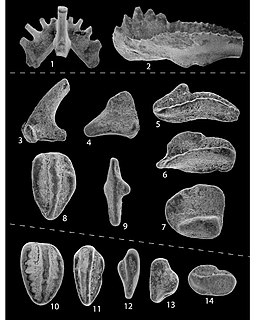Related Research Articles
The Carboniferous is a geologic period and system of the Paleozoic that spans 60 million years from the end of the Devonian Period 358.9 million years ago (Mya), to the beginning of the Permian Period, 298.9 Mya. The name Carboniferous means "coal-bearing", from the Latin carbō ("coal") and ferō, and refers to the many coal beds formed globally during that time.
The Pennsylvanian is, in the ICS geologic timescale, the younger of two subperiods of the Carboniferous Period. It lasted from roughly 323.2 million years ago to 298.9 million years ago. As with most other geochronologic units, the rock beds that define the Pennsylvanian are well identified, but the exact date of the start and end are uncertain by a few hundred thousand years. The Pennsylvanian is named after the U.S. state of Pennsylvania, where the coal-productive beds of this age are widespread.
In the geologic timescale, the Asselian is the earliest geochronologic age or lowermost chronostratigraphic stage of the Permian. It is a subdivision of the Cisuralian Epoch or Series. The Asselian lasted between 298.9 and 295 million years ago (Ma). It was preceded by the Gzhelian and followed by the Sakmarian.
The Bashkirian is in the ICS geologic timescale the lowest stage or oldest age of the Pennsylvanian. The Bashkirian age lasted from 323.2 to 315.2 Ma, is preceded by the Serpukhovian and is followed by the Moscovian.
The Kasimovian is a geochronologic age or chronostratigraphic stage in the ICS geologic timescale. It is the third stage in the Pennsylvanian, lasting from 307 to 303.7 Ma. The Kasimovian Stage follows the Moscovian and is followed by the Gzhelian. The Kasimovian saw an extinction event which occurred around 305 mya, referred to as the Carboniferous Rainforest Collapse. It roughly corresponds to the Missourian in North American geochronology and the Stephanian in western European geochronology.

The Gzhelian is an age in the ICS geologic timescale or a stage in the stratigraphic column. It is the youngest stage of the Pennsylvanian, the youngest subsystem of the Carboniferous. The Gzhelian lasted from 303.7 to 298.9 Ma. It follows the Kasimovian age/stage and is followed by the Asselian age/stage, the oldest subdivision of the Permian system.
The Moscovian is in the ICS geologic timescale a stage or age in the Pennsylvanian, the youngest subsystem of the Carboniferous. The Moscovian age lasted from 315.2 to 307 Ma, is preceded by the Bashkirian and is followed by the Kasimovian. The Moscovian overlaps with the European regional Westphalian stage and the North American Atokan and Desmoinesian stages.

The Alamitos Formation is a geologic formation exposed in the southern Sangre de Cristo Mountains of New Mexico. It preserves fossils dating back to the late Pennsylvanian to early Permian periods.
Idiognathodontidae is an extinct conodont family.

Gnathodus is an extinct conodont genus in the family Idiognathodontidae.
Diplognathodus is an extinct genus of conodonts in the family Anchignathodontidae. Specimens are found in Carboniferous and Permian formations.
Metapolygnathus is an extinct genus of platform conodonts.
Streptognathodus is an extinct genus of conodonts from the Late Carboniferous to Early Permian.
Conodonts are an extinct class of animals whose feeding apparatuses called teeth or elements are common microfossils found in strata dating from the Stage 10 of the Furongian, the fourth and final series of the Cambrian, to the Rhaetian stage of the Late Triassic. These elements can be used alternatively to or in correlation with other types of fossils in the subfield of the stratigraphy named biostratigraphy.
Dollymae is an extinct genus of conodonts.
Siphonodella is an extinct genus of conodonts.
Neognathodus is an extinct genus of conodonts.
Declinognathodus is an extinct genus of platform conodonts.
Idiognathoides is an extinct genus of conodonts.

The Porvenir Formation is a geologic formation exposed in the southeastern Sangre de Cristo Mountains of New Mexico. It preserves fossils dating back to the middle Pennsylvanian period.
References
- ↑ Conodonts from the Fort Scott Limestone of Missouri. Frank H. Gunnell, Journal of Paleontology, Vol. 5, No. 3 (Sep. 1931), pages 244-252 (Stable URL)
- ↑ Visean–Moscovian conodont biostratigraphy of the Ko-yama Limestone Group, Akiyoshi Belt, SW Japan. Keisuke Ishida, Sigeyuki Suzuki and Noriyuki Inada, Natural Science Research, Univ. Tokushima, 2013, volume 27 (3), pages 29–52
- 1 2 Moscovian conodonts from the Nevandi River Valley (Cantabrian Zone, North Spain). C.A. Méndez, Trabajos de Geología, 2012, volume 32, pages 63–75
- 1 2 Geometric morphometric analysis and taxonomic revision of the Gzhelian (Late Pennsylvanian) conodont Idiognathodus simulator from North America. Nicholas J. Hogancamp, James E. Barrick and Richard E. Strauss, Acta Palaeontologica Polonica, 2016 (in press), doi:10.4202/app.00198.2015